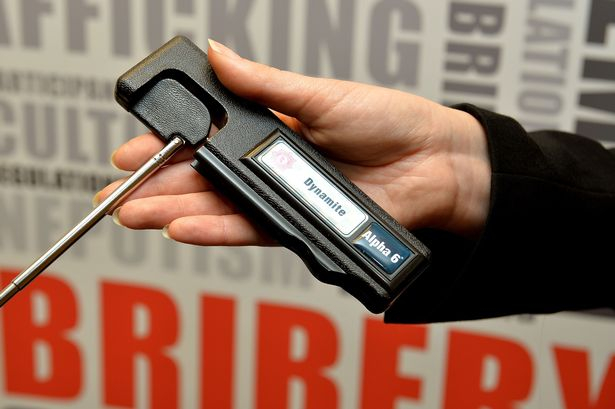Top 10 Baffling Scams That Shouldn’t Have Worked (But Did)
The majority of philosophies would have you think that people are inherently good. If left to our own devices, we all tend to gravitate toward what is right, ... read more...which gives birth to the idea that right and good are abstract ideas. But then someone comes along and wrecks the whole plan because they appear like complete scumbags who are just out to take advantage of others in the most dubious ways conceivable. Scams that are so absurd that there is no way they should succeed, but some how they do.
-
It's time to acknowledge Gregor MacGregor for pulling off what is arguably the most incredible con ever. He created an entire nation from scratch and persuaded others to believe in it. MacGregor was born in England in 1822, the son of a banker and a former soldier. But was he? He started spreading the rumor that he was actually a prince from the Poyais kingdom. Do you know Poyais? If you don't look at any maps because it's not a real place, you can't miss it right down there near Honduras.
The ruler of the Mosquito Coast Territory, which is now in modern-day Honduras and Nicaragua, had handed MacGregor eight million acres of that territory. Despite becoming his, the government still had jurisdiction over the land. However, British elites who had no understanding what they were doing at the moment were investing heavily in South America.
To deceive wealthy investors, MacGregor invented a whole fictitious nation replete with a flag and a book. Selling off land that people thought would prosper and provide a return on investment, he made the equivalent of millions. To move there, hundreds packed everything. But there was absolutely nothing there for them. Less than one third made it back to England unharmed. Before their passengers sailed, five more ships had to be halted. MacGregor, for his part, eluded capture and resorted to the same con. After being captured, he escaped once more and ended up in Caracas, where he lived out the remainder of his days.
https://allthatsinteresting.com/ 
https://allthatsinteresting.com/ -
Have you ever seen a commercial offering to transform a loved one's cremains into a diamond as a means to keep their memory alive forever? There are numerous businesses that provide the service. The issue is that everything is a con.
The theory is that since diamonds and cremation remains are both made of carbon, a lab-created diamond can be manufactured from the remains. However, according to specialists, cremation remains include an extremely little amount of material that might be used to create a diamond. There needs to be more added in order to determine the diamond's makeup.
As most people are aware, carbon makes up diamonds. There is no carbon left behind after a body has been burned since cremation furnaces must burn between 1600 and 1800 degrees Fahrenheit while carbon burns at 1400 degrees Fahrenheit. There is no way to make a diamond from a loved one's remains if there is no carbon remaining.
In their US patents, these "cremation diamond" businesses actually acknowledge that there isn't enough carbon left over from the cremation process to create a diamond. Instead, these businesses produce their "cremation diamonds" using external carbon sources. There is no guarantee that any of your loved ones' remains are anywhere inside the phony diamonds that companies sell for more money than natural diamonds of the same size.

https://www.kloiberjewelers.com 
http://cremationinstitute.com -
The idea of scam schools is not new. One of the most well-known instances is Trump University, but there are numerous more businesses that can sell you a false diploma online. But because the school and the pupils weren't fakes, this swindle from China played out in a pretty odd way. It's only that they are unrelated to one another.
At least 68 students believed they were enrolled for the equivalent of roughly $1,200 per year at Shandong Institute of Light Industry as part of a phony diploma scandal. They performed all of their work, went to class, and were about to graduate when they discovered that none of them had actually been enrolled. In case you were wondering, that's four full years of education. No one from the school was involved; it was just a guy and his pals who turned up every day for four years to instruct these youngsters in empty classrooms.

Photo for illustration only, https://squline.com/ 
Photo for illustration only, https://www.china-admissions.com/ -
Medical frauds are usually terrifying since the results are almost never good. That most certainly applies to Dr. John Brinkley, who wasn't even a doctor. But he did become famous because, in the 1920s and 1930s, he provided a treatment for impotence when none of the others worked. Sadly, his scam remedy wasn't something as safe as an energizing tonic. In his human patients, the man was stitching goat testicles.
Unbelievably, goat testicles don't make you more sexually active. However, they did make Brinkley a millionaire, and as a result, he launched his own radio station in Mexico. He successfully transplanted the goat testicles and sealed them inside, therefore the procedure "worked." They would eventually be eliminated by the patient's immune system over time as foreign objects. Of course, given the surgery was pointless, it is unlikely that anyone had greater virility. Unsurprisingly, he was also the target of numerous malpractice lawsuits.

https://www.thepennyhoarder.com/ 
https://bottomlineinc.com/ -
Even though this scam may be among the most well-known ever, it's strange to assume that anyone has ever fallen for it. The Brooklyn Bridge was sold by George Parker. Over and over. Additionally, he sold the Metropolitan Museum of Art, Grant's Tomb, and the Statue of Liberty. The individual was exceptionally skilled in his field. Some of his victims attempted to erect toll booths in order to profit from their recent acquisition.
Paker eventually succeeded in extracting as much as $50,000 from his customers, which was a sizable sum of money in the late 1800s. Other times, he was content with just $75. According to some estimations, he may have sold the bridge twice a year for 40 years using fraudulent deeds to market his fake assets. He was accused of fraud in 1908 but managed to escape punishment by stealing the coat and hat of a police officer. He wouldn't actually be taken to Sing Sing until 1928, and he passed away there 8 years later.

https://untappedcities.com/ 
https://www.tripsavvy.com -
Do you recall the diet that involved chocolate? Online, you may still see 2015 articles that rejoice the discovery that chocolate can aid in weight loss. When it became clear that the entire scheme was fraudulent, some articles were revised, while others had their wording altered after the fact. but not in a negative way.
A journalist by the name of John Bohannon broke the story. He created the fictitious account to illustrate the ease with which news regarding nutrition and health is disseminated without any careful consideration or examination. Nobody verifies the veracity of the report.
It was a true study with 16 people who had a low-carb diet along with a daily chocolate bar. However, the approach was horrible on purpose. The results might have been tainted since the group was too small and there were too many factors present. None of the media outlets that published their story cared that it was terrible science.

http://www.redacre.com 
https://www.avatarnutrition.com -
An elevated bus story from China in 2016 briefly captured the attention of the internet. By allowing vehicles to pass directly underneath it, the bus was made to reduce traffic congestion. The bus was raised on slender side supports, but the middle was open and large enough for passing cars to do their daily driving. No more waiting for passengers to board and off the bus, right? Actually, not quite.
There was a difficulty with the bus, however it did exist. It was shown rolling up and down a section of road repeatedly, but it didn't accomplish anything else. And as the days went by, the bus remained stationary. It was left in the middle of the street. However, it was still passable, so it wasn't all that horrible.
The entire initiative turned out to be a fraudulent fundraising scheme. In connection with the fraud meant to raise capital from investors for a project that was ostensibly never planned to get off the ground, thirty people were detained.
https://inhabitat.com/ 
https://www.nytimes.com/ -
Some frauds are a bit sleazier than others. Overcharging for a melon is one thing, but to act in a way that could cause death is something else entirely. James McCormick, a con artist, received a 10-year prison sentence as a result.
In Iraq, McCormick was operating a scam. He had made a fortune selling bomb detectors to various governments and organizations. Some sold for just £5000, while on one occasion he conned his way to £500,000 for one. They were not, however, actual bomb detectors. They were modified models of the Gopher, a gadget used for retrieving golf balls. And for £53 million, he sold 5,000 of them to Iraq. Sales totals are unknown, however they may have exceeded £100 million.
The devices had been exposed as fakes in the US years earlier, but the inventor relocated to the UK, where McCormick became engaged. Additionally, more than one agency there found them to be worthless fakes, but nothing was done about it. They were merely empty boxes with antennae and lights that had no connections and served no purpose at all.Multiple people died as a result of McCormick's fraud, and numerous others were imprisoned by dishonest officials.
https://www.mirror.co.uk/ 
https://sites.tufts.edu/ -
The average person on the street thinks that art scams are a little too sophisticated. How often do you actually purchase new paintings? Naturally, it must be a little simpler to pull off if you're not on the street as it frequently occurs while people are at sea.
Art purchasers who were duped by fraudulent art auctions while on cruises in foreign waters have filed multiple lawsuits against a Detroit gallery called Park West. Ten clients accused them of doing this back in 2009. Every year, it appears that these auctions bring in hundreds of millions of dollars for cruise lines, which are shared between them and the galleries who provide the artwork.
The issue is that some of the work is counterfeit. Somehow, passengers are led to believe that their cruise line has a real Picasso or Dali. The business has been involved in 21 lawsuits since 2008. The cruise line and gallery are accused of coercing and lying to buyers while also entertaining them to pull off the scheme.

https://www.cruisecritic.com/ 
http://disneycruiselineblog.com -
What would you do if you unintentionally bumped with a stranger while crossing a busy street, causing them to drop their prized melons? Would you apologize? Perhaps you could pay them a few dollars for their melon? Then this scam isn't for you because it can defraud victims of $60 or more per. That is, melon pop.
You're going to see a lot of tourists from countries like Japan in a busy metropolis like New York. Additionally, a watermelon can cost far more in Japan than in New York. Scammers are aware of this and will purposefully get in the way, get bumped, and drop the fruit when they spot some Japanese tourists. Scammers may receive up to ten times the value of the melon from the extremely repentant and contrite visitor who offers to pay for it. Feel free to call them out on it if you ever find yourself in a position similar to that, or make a police call.

http://www.jonnynow.com/ 
https://www.stocktalkreview.com/































